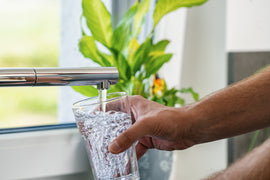Kitchen faucets range in style and features which change the look and convenience of their use. Knowing what to look for in a kitchen faucet depends on your preferred design and desired functionality. We’ve put together a simple kitchen faucet buying guide with tips to help you as you search for the perfect fit.
Decide Between Traditional and Modern
The traditional kitchen sink faucet has two handles, one for cold water and one for hot, making it easy to adjust the temperature. The water comes out of a central, curved spout as part of a sleek yet standard kitchen sink faucet that’s typically made of stainless steel. However, modern updates to the traditional design include a one-handle faucet with a faucet spout that moves back and forth to adjust temperature.
There’s also a touchless faucet design that makes cooking simpler, especially when you don’t want to risk cross-contamination when handling raw meat or eggs. These are commonly made of stainless steel as well, but brass, nickel, and gold are also popular options.
Match the Functionality with Your Sink Size
Another factor to consider when deciding what to look for in a kitchen faucet is the size of your sink. A standard single-sided sink may only require a stationary faucet. On the other hand, a two-sided, deeper sink may benefit from a pulldown faucet that switches between a steady stream of water and a spray from the nozzle.
A spray option is helpful when washing dishes or rinsing off vegetables. It also comes in handy when cleaning the sink. However, this particular size and functionality may be overwhelming for a smaller sink used primarily to wash your hands and rinse off dishes. Depending on the shape of your current sink and the size of the holes, make sure your chosen kitchen faucet will fit the current setup of your kitchen design.
Consider a Smart Faucet for Automatic Functions
An increasing number of people use at least one smart device for their home. Smart faucets are yet another technology available for people who enjoy the convenience of gadgets. The smart faucet design is a similar model to the standard faucet, with a curved neck and temperature handles. However, smart technology can be programmed to dispense a certain measurement of water for baking or cooking, automatically adjust the water to your chosen temperature, and can even show you how much water you’re using per day.
The design and concept is alluring as one of the latest kitchen gadgets available enabled by smart technology. The caveat with a higher-end model is higher maintenance. A smart faucet must be installed and fixed by a professional, which may go beyond the quicker DIY project you had in mind for your kitchen design.
Include a Secondary Sink to Free Up Space
Part of what to look for in a kitchen faucet depends on your layout. Many modern kitchen sink designs include a smaller, secondary sink that matches the main faucet but can be reserved primarily for filtered drinking water or water used for cooking only.
The main sink has a big enough basin and a faucet with a nozzle to wash dishes and rinse produce. Those that have the space in their kitchen appreciate a separation of sinks to perform different duties, since a smaller sink can be directly connected to a water dispenser or be the faucet used for a faucet filter installation.
Find a Faucet Compatible with Filtration System
Think big picture when deciding what type of kitchen faucet to get by deciding if you’ll want to install a water filtration system. Most faucet models are compatible with the FloFaucet with the exception of the pull-down faucet. This versatility leaves plenty of room to customize the style, shape, and fit of the faucet you want. The value of the FloFaucet water filter is that it transforms your tap water at the source and provides a constant stream of purified water in a way that’s simple to use and maintain.
How Does a Faucet Filter Work?
The FloFaucet is guaranteed to remove or reduce 80+ contaminants from your tap water through a five-stage micro carbon block filter process. It’s easy to install without the need for tools and allows you to transition between tap water and FloWater as necessary. FloFaucet provides twice the flow rate of a typical kitchen faucet filter and results in great-tasting water every time.
Another benefit of the FloFaucet is that it eliminates the need for single-use plastic water bottles. It saves an average family of four approximately $700 per year versus the cost of drinking bottled water. Plus, it cuts down on the total amount of plastic waste used in the home. It’s a cost-efficient, environmentally-friendly solution that proves convenient for those who prefer the taste, look, and quality of purified water versus what’s available straight from the tap, which may not always be ideal to drink.
Importance of Water Filtration for Your Health
Water filtration is important for your health because there are dozens of contaminants, chemicals, and pollutants found in big city tap water that can cause adverse health conditions. Furthermore, the water from the sink simply may not look or taste good.
The U.S. Environmental Protection Agency (EPA) Safe Drinking Water Act regulates the level of contaminants found deemed safe for health. The frequency of city water testing depends on how many people the water supply serves, the type of water source, and the levels of contaminants found in the water. These include bacteria, viruses, and other pollutants, as well as various chemicals. It’s especially important to understand the indicators of water quality.
Bacteria or viruses found in tap water can lead to side effects such as vomiting, diarrhea, fever, and headaches. Chemical exposure through drinking water can result in harmful health effects as well, ranging from skin discoloration or irritation to nervous system and organ damage. Both high levels of chemicals in the water and low levels of chemicals consumed over a long period of time can also lead to chronic conditions, such as cancer. Those commonly found in tap water include lead, mercury, arsenic, and chlorine/chloramines.
- Lead - Lead is one of the main contaminants found in public water systems today due to outdated pipes. Lead exposure results from the corrosion of older fixtures and solders that connect the pipes, either in the home or via city systems, which leach into the water and straight to your tap. This toxin is harmful even at the lowest exposure levels because it can accumulate in the body. The EPA has set the maximum contaminant level of lead in drinking water to zero because of its damaging effects.
- Mercury - Mercury found in tap water is often the result of runoff from industrial waste. Cities that rely on water sources located near large factories may have more mercury in their tap water than other areas. It, too, builds up in the body, which means exposure to it even at lower levels can still prove poisonous over time. Mercury can cause involuntary muscle movements, deteriorate the nervous system, and impair the senses, among its many health effects.
- Arsenic - Another toxic pollutant often found in tap water is arsenic. It’s a naturally occurring element found in rocks and soil and used for industrial and agricultural activity. However, when combined with other chemicals, it forms pesticides and herbicides to protect crops but are dangerous to human health. Runoff from these areas seep into the groundwater supplies and end up in your drinking water.
- Chlorine/Chloramines - Chlorine and/or chloramines are regularly used as disinfectants to treat drinking water. Although these chemicals have been used for decades to rid the water supply of other contaminants, research shows certain byproducts are linked to harmful health conditions, such as cancer, problems with the liver, kidney, and central nervous system, and anemia.
These chemicals represent a sample of what is polluting your tap water. The EPA carefully regulates the amounts and types of contaminants to ensure safe drinking water, but some areas struggle more than others to keep their city water safe. Environmental challenges, such as proximity of main water supply to industrial or agricultural runoff, and old water pipes that change the levels of the contaminants between testing are two of the main problems cities face.
Installing a water filter on your kitchen faucet is the easiest way to reduce the amount of exposure you have to chemicals and other pollutants in the environment including your tap water.
What Type of New Faucet Will Work Long-Term?
Consider the tips shared in our kitchen faucet buying guide to help you decide which one works best for you. Compare styles and sizes, functions and features when narrowing down your choices. Make sure the one you choose is compatible with a water faucet filter to save you time and money in the long-term.
By using your original tap water source to transform it into purified, crisp drinking water on-demand creates convenience for your home. It allows you to get the hydration you need whenever you turn on your new faucet. With the variety of kitchen faucet designs available, you’re sure to find the one you’ll be satisfied with for years to come.
Sources:
https://www.bobvila.com/articles/types-of-kitchen-faucets/
https://www.cdc.gov/healthywater/drinking/drinking-water-faq.html
https://www.consumerreports.org/cro/faucets/buying-guide/index.htm





